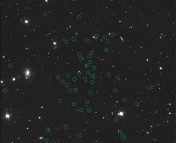The Undergraduate Research series is where we feature the research that you’re doing. If you are an undergraduate that took part in an REU or similar astro research project and would like to share this on Astrobites, please check out our submission page for more details. We would also love to hear about your more general research experience!

James Kwon
UC Berkeley
This guest post was written by James Kwon. James Kwon is a senior at UC Berkeley, majoring in astrophysics and physics. This work constitutes a part of his senior thesis and has been supervised by Professor Joshua Bloom. This work was presented during the 237th AAS Conference iPoster Session (350.02).
Cosmic-ray (CR) contamination of observational images is caused by high-energy charged particles landing on detecting devices. As with other space-based detectors, the Hubble Space Telescope (HST) suffers cosmic-ray contamination, mainly originating from the radiation belt of the Earth. When the CR lands on detectors (the charged coupled devices, for example), the contaminated pixels accumulate significant quantities of charge resulting in abnormally high pixel values in images as illustrated in the figure below. An example of this contamination is shown in Figure 1. At the center of the first and the second panel from the left, the CRs can be easily identified. However, the difficulty to resolve CRs against normal sources increases as the density of sources increases; in the third and fourth panel, most of the CRs are not visually identifiable.

deepCR (Zhang & Bloom 2020; hereafter the original model) is a deep-learning-based framework for CR identification/replacement trained with HST ACS/WFC F606W data (F606W is a filter that covers midrange of optical wavelengths. ACS stands for Advanced Cameras for Surveys and WFC is Wide Field Channel). The original model has proven its potential in outperforming the current best-in-class solution, LACosmic (van Dokkum 2001; a CR identification pipeline utilizing Laplacian Edge detection), in detection rates of CR contaminated pixels and speed, but is limited to be used only for F606W data.
We further assembled new training sets with 25,200 images taken by HST ACS/WFC F435W, F606W, and F814W filters. The training images can be classified as three categories: extragalactic fields, globular clusters, and resolved galaxy images, so that the model can be trained with images of various difficulties. The source density (hence the difficulty) is lowest in the extragalactic fields, followed by globular clusters, and is highest in the resolved galaxy images.
We trained three individual filter models with respective training sets for each filter and one global model – deepCR-ACS/WFC – with the entire training set. The global model retained the excellent performance of the original model, showing near 100% detection rate of CRs in extragalactic field, 95% in globular cluster, 90% in resolved galaxy images. Furthermore, the global model did not display significant performance difference from the individual filter models, which suggests that the global model is a sufficient substitute for the individual models. As deepCR-ACS/WFC retains the speed boost of 90 times as compared to LACosmic due to GPU support, it is expected to greatly aid CR processing for HST ACS/WFC photometry.
Astrobite edited by: Ishan Mishra




